MARIANI’S
March 19, 2006
NEWSLETTER
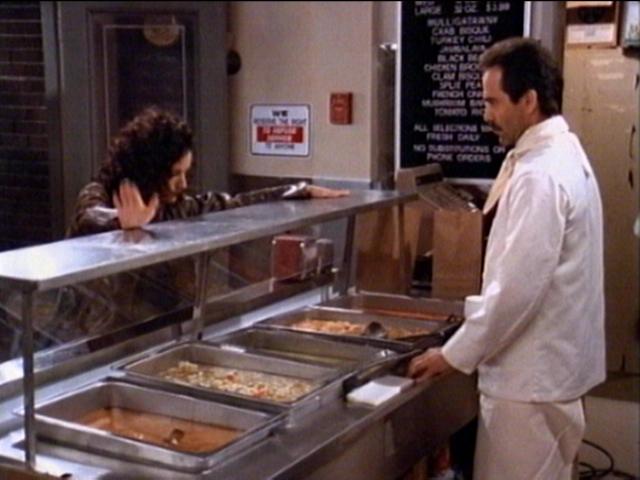
UPDATE: To
go to my web site, in which I will update food
&
travel information and help link readers to other first-rate travel
& food sites, click on: home page
ACCESS TO
ARCHIVE: Readers may now access
an
Archive of all past newsletters--each annotated--dating back to July,
2003, by simply clicking on www.johnmariani.com/archive
.
NEW
FEATURE! You may now subscribe anyone you wish
to this newsletter by
clicking here.
In
This Issue
IN SEARCH OF BEAUTIFUL SOUPS by John Mariani
NEW YORK CORNER: Compass by John Mariani
QUICK BYTES
~~~~~~~~~~~~~~~~~~~~~~~~~~~~~~~~~~~~~~~~~
by John Mariani
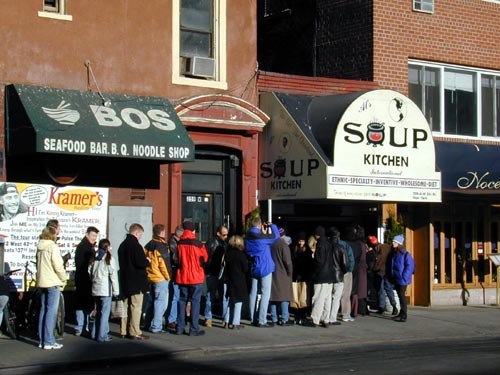
Played to monomaniacal perfection by actor Larry Thomas, with an accent from somewhere in the Middle East, the Soup Nazi intimidated anyone and everyone who lined up to order his wares, and any deviance from established rules of order was met with immediate banishment from his store. In the end, Elaine Benes, whom he'd banned from his shop, accidentally comes across Soup Nazi's recipes in a drawer and threatens to publish them and drive him out of business. "You're through, Soup Nazi!" she screams, as the character of Newman scrambles to get the last container of jambalaya.
As every fan of the series knows, the Soup Nazi was based on a real person, Al Yaganeh, whose tiny storefront (above) on West 55th Street in NYC named Soup Kitchen International did indeed have a reputation for excellent soups and for Yaganeh's dismissive attitude towards customers who had the temerity to stammer or hold up the line. I know from personal experience: Esquire Magazine's office used to be located right across the street from his store, and I, like everyone else on line, become more and more anxious as we moved up in the line. I'd select my soup, and Yaganeh would glare at me like Rasputin, shouting, "Large or small?" I'd stammer, "Large, please" fearing he'd think me a wuss if I ordered small. "Bread?" Yes, of course, bread, please. "Nineteen dollars," he'd shoot back and thrust his hand out in a way that suggested "Hurry up with the money." Neither I nor anyone on line would dare quibble that nineteen dollars is a lot for soup, however good. No one ever jokes with Yaganeh about the Soup Nazi either, for being Jewish, he has long been offended by his "Seinfeld" impersonator being characterized as a Nazi in the show. Nevertheless, the lines outside his store never stopped after the show's airing.
Now, according to a report published last week in Business Opportunities Journal (click), Yaganeh has contracted to franchise his soups. He and his management team are gearing up to put the soups in 1,000 locations in the
There were plenty of other food-related episodes on "Seinfeld" but none was funnier or struck a more responsive chord than the "Soup Nazi," for, when all is said and done, a good soup is hard to find. Too often soups are neglected by restaurant chefs who seem to put one on the menu simply because they are expected to. Yet Sirio Maccioni, owner of NYC's Le Cirque (to re-open in June), once told me that “A restaurant cannot call itself a restaurant if it doesn’t serve good soups,” an opinion I wholeheartedly share, especially at a time when young chefs haven’t a clue how to make a good consommé and long ago forgot what goes into an authentic bouillabaisse or a New England chowder.
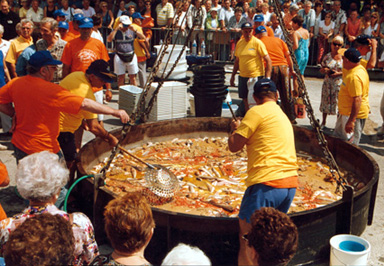 Bouillabaisse
(pronounced boo-yah-bayss,
not boo-yah-bayze), a ruddy,
garlic-rich seafood
soup whose name means “boil and reduce,” which refers to its being
brought to
the boil once, then simmered down, then brought up to the boil again,
is a soup created by Marseilles fisherman
who sold the best of the day’s catch and saved the lesser fish
to produce this mighty flavorful tomato-and-saffron laced soup. The people of Marseilles are rightly proud of their
creation, which they celebrate in festivals (left), though you can easily get a
watered-down version even there. There are hundreds of
variations—despite a
1980 charter signed by Marseilles restaurateurs as to what can and
can’t get
thrown into a bouillabaisse (by
one
count
more than 40 species, especially rockfish and shellfish like mussels
and crabs)—but only upscale
restaurants would dare or could afford to put
expensive lobster and saffron in the pot. If
you wish to try the soup right on the spot, eat down by
the docks at places like Des Mets de
Provence (18 Quai de
Rive-Neuve;
04-91-33-3538) and Miramar
(12 Quai Port; 04-91-91-1040; click
), and in Paris, at the elegant Goumard
(9 Rue Duphot; 01-42-60-3607).
For some odd reason in the U.S. chefs have shied away from serving the
soup while sometimes using a "bouillabaisse sauce" as the underpinning
for seafood dishes.
Bouillabaisse
(pronounced boo-yah-bayss,
not boo-yah-bayze), a ruddy,
garlic-rich seafood
soup whose name means “boil and reduce,” which refers to its being
brought to
the boil once, then simmered down, then brought up to the boil again,
is a soup created by Marseilles fisherman
who sold the best of the day’s catch and saved the lesser fish
to produce this mighty flavorful tomato-and-saffron laced soup. The people of Marseilles are rightly proud of their
creation, which they celebrate in festivals (left), though you can easily get a
watered-down version even there. There are hundreds of
variations—despite a
1980 charter signed by Marseilles restaurateurs as to what can and
can’t get
thrown into a bouillabaisse (by
one
count
more than 40 species, especially rockfish and shellfish like mussels
and crabs)—but only upscale
restaurants would dare or could afford to put
expensive lobster and saffron in the pot. If
you wish to try the soup right on the spot, eat down by
the docks at places like Des Mets de
Provence (18 Quai de
Rive-Neuve;
04-91-33-3538) and Miramar
(12 Quai Port; 04-91-91-1040; click
), and in Paris, at the elegant Goumard
(9 Rue Duphot; 01-42-60-3607).
For some odd reason in the U.S. chefs have shied away from serving the
soup while sometimes using a "bouillabaisse sauce" as the underpinning
for seafood dishes.Pistou (right) is another beloved soup of the Riviera, specifically from Nice, where the word refers to the process of crushing the requisite basil and herbs with a pestle and mortar. Wonderfully fragrant with olive oil and garlic and riddled with green beans and carrots, it is usually served with a sprinkling of Parmesan cheese and is a close cousin to
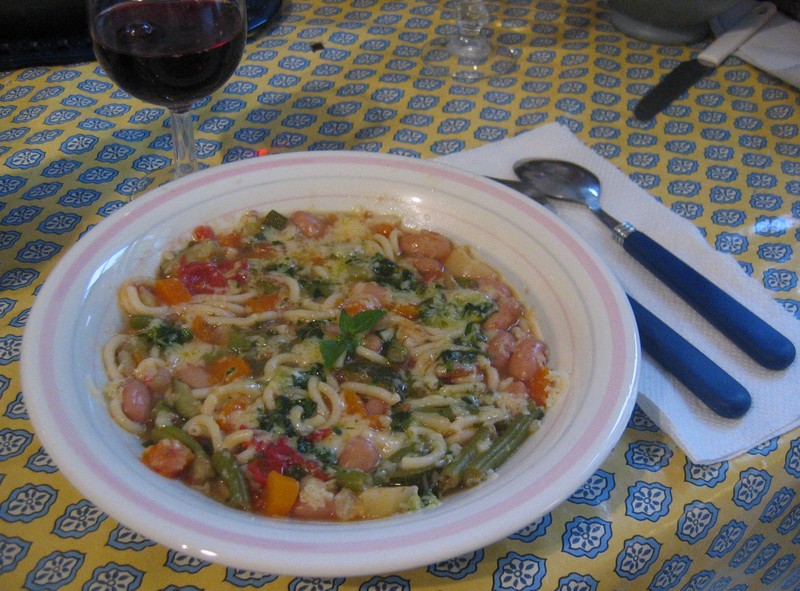 the Genoese
paste called pesto. To enjoy it at a little restaurant near
the beach
in Nice, with a
glass of rosé wine and a crusty bread is to eat well indeed. In
Nice
there is
an Association de la Capelina d’Or of
chefs who pledge themselves to serving the traditional dishes like
pistou, none
better than at Lou Pistou (4 rue de la Terrasse; 04-9362-2182)
in the Old Town.
the Genoese
paste called pesto. To enjoy it at a little restaurant near
the beach
in Nice, with a
glass of rosé wine and a crusty bread is to eat well indeed. In
Nice
there is
an Association de la Capelina d’Or of
chefs who pledge themselves to serving the traditional dishes like
pistou, none
better than at Lou Pistou (4 rue de la Terrasse; 04-9362-2182)
in the Old Town.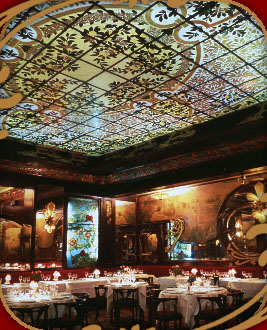 Billi-bi, a
soup of mussels and cream and a hit of
cayenne
pepper, does not sound French, although it was created at the famous
Deauville
restaurant Ciro’s back in 1925 and named after a valued American
customer named
William Brand (not, as some have claimed after tin tycoon William
Bateman
Leeds, who died in 1908). In a true
billi-bi the mussels are strained from the final presentation and then
bulked
up with an egg yolk. It is exceptionally
rich but, when well made, quite light too. The dish became a signature
item at Maxim’s (left; 3 Rue Royale; 42-65-2794; click ) in Paris,
one of the few places
you’ll still
find it in town.
Billi-bi, a
soup of mussels and cream and a hit of
cayenne
pepper, does not sound French, although it was created at the famous
Deauville
restaurant Ciro’s back in 1925 and named after a valued American
customer named
William Brand (not, as some have claimed after tin tycoon William
Bateman
Leeds, who died in 1908). In a true
billi-bi the mussels are strained from the final presentation and then
bulked
up with an egg yolk. It is exceptionally
rich but, when well made, quite light too. The dish became a signature
item at Maxim’s (left; 3 Rue Royale; 42-65-2794; click ) in Paris,
one of the few places
you’ll still
find it in town.On the other hand, what could be more French than the famous cold leek-and-potato soup named vichyssoise? The problem is, although a French chef, Louis Diat, created it, it was first made as a summer soup in steamy New York City. Diat came to work at the new Ritz-Carlton Hotel in New York in 1910 and found that there were no leeks being grown in the region.
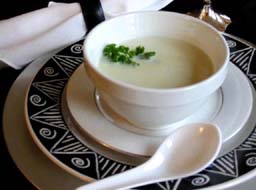 He thereupon contracted a farmer
to do so, and, sometime afterwards, during a typical hot New York
summer, Diat
served a cold version of his beloved mother’s hot leek-and-potato soup
and
named it after his hometown, Vichy. And
for those who think jingoism began with a call by an imbecile U.S.
Congressman to change the name
“French
fries” to “Freedom fries” in federal cafeterias after the onset of the
current
Iraqi war unsupported by France, the fact is that during World War II
many
French chefs in New York changed the name vichyssoise to “crème
Gauloise”
because of their hatred of Vichy’s collaboration with the Germans.
After the
war, they reverted to calling it vichyssoise.
He thereupon contracted a farmer
to do so, and, sometime afterwards, during a typical hot New York
summer, Diat
served a cold version of his beloved mother’s hot leek-and-potato soup
and
named it after his hometown, Vichy. And
for those who think jingoism began with a call by an imbecile U.S.
Congressman to change the name
“French
fries” to “Freedom fries” in federal cafeterias after the onset of the
current
Iraqi war unsupported by France, the fact is that during World War II
many
French chefs in New York changed the name vichyssoise to “crème
Gauloise”
because of their hatred of Vichy’s collaboration with the Germans.
After the
war, they reverted to calling it vichyssoise. Another
cold soup--Spanish gazpacho, made with tomatoes, garlic and
vegetables—has quite an ancient etymology, going back to the Arabic casba,
referring to the pieces of fragments of bread and vegetables in the
soup. There
are many variations throughout Spain, where it is often as much a salad
as
soup, but the gazpacho now on menus throughout the rest of the world
has been
familiar at least since the middle of the 19th century. You'll find it
in most traditional Spanish restaurants, including the wonderful El Faro (15 San Felix; 902-21-1068; click) in Cadiz, a predominantly seafood restaurant where they make a fine creamy version.
Another
cold soup--Spanish gazpacho, made with tomatoes, garlic and
vegetables—has quite an ancient etymology, going back to the Arabic casba,
referring to the pieces of fragments of bread and vegetables in the
soup. There
are many variations throughout Spain, where it is often as much a salad
as
soup, but the gazpacho now on menus throughout the rest of the world
has been
familiar at least since the middle of the 19th century. You'll find it
in most traditional Spanish restaurants, including the wonderful El Faro (15 San Felix; 902-21-1068; click) in Cadiz, a predominantly seafood restaurant where they make a fine creamy version.Yet another cold soup—though sometimes served hot—is borscht, made from beets, beef, and cabbage laced with a generous dollop of sour cream. The word is a Yiddish form of the Russian borsch, which actually means “cow parsnips,” the soup’s original ingredient. So associated with Jewish immigrants in America was borscht that Variety editor Abel Green coined the word “Borscht Belt” as a synonym for New York’s Catskill Mountain resorts frequented by Jewish patrons and entertainers. Were I in New York I’d head straight for the Carnegie Deli (854 Eighth Avenue; 212-757-2245; click) and order the borscht and split a pastrami and tongue sandwich.
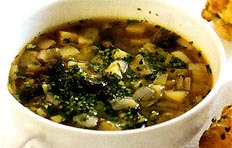
British culinary terminology is rife with deliberately funny-sounding terms, including bubble-and-squeak (mashed potatoes, chopped cabbage, and boiled beef), angels on horseback (oysters wrapped in bacon), dead man’s leg (jelly roll cake), and spotted dick (a suet pudding with raisins). In the nomenclature of soup, the Scots gave us cock-a-leekie (right), made with an old hen too tough for roasting or frying, and leeks, bacon, and herbs, then garnished with prunes and leeks. It dates back at least into the 18th century under that name, though is much older as a soup. They still serve traditional cock-a-leekie soup at London's St. John Bar & Restaurant (26 St. John Street; 011-44-[0]207-251-0848; click), along with a plate of rich marrow bones.
Brits also love the savory, often peppery Indian chicken-and-spice soup called mulligatawny, whose name is
Some soup names sound as improbable as hot dogs, which contain no dog, and hamburgers, which contain no ham.
 Mock turtle
soup at least alludes to its not being made with turtle (which itself
makes a
great dish, often called “snapper soup,” when made from snapping
turtles);
instead it is made with calves’ brains, whose texture and flavor
resembles
turtle meat. Obviously the dish has been
around a long time in England, since Lewis Carroll turned it into the
character
of a mock turtle (left) in Alice’s
Adventures in Wonderland (1865),
who croons
the ditty, “Beautiful soup, so rich and green,/Waiting in a hot
tureen!/ Who
for such dainties would not stoop?/Soup of the evening, beautiful soup!”
Mock turtle
soup at least alludes to its not being made with turtle (which itself
makes a
great dish, often called “snapper soup,” when made from snapping
turtles);
instead it is made with calves’ brains, whose texture and flavor
resembles
turtle meat. Obviously the dish has been
around a long time in England, since Lewis Carroll turned it into the
character
of a mock turtle (left) in Alice’s
Adventures in Wonderland (1865),
who croons
the ditty, “Beautiful soup, so rich and green,/Waiting in a hot
tureen!/ Who
for such dainties would not stoop?/Soup of the evening, beautiful soup!”Chinese bird’s nest soup is neither a euphemism nor a joke. It really is made from the nest of a swallow that eats seaweed causing it to release a gelatinous saliva with which it makes its nests. These are then soaked overnight before being combining with other ingredients to make soup. These nests are very expensive and considered a great delicacy in China, so don’t expect to find it cheap or readily at your local Lotus Tiger Dragon Imperial Garden. You should be able to find it in the best restaurants in Chinatowns in New York, San Francisco, and Chicago, but it’s always crucial to call in advance.
American cooks, whose origins are from all over the world, have often taken an old idea and name and turned them into regional soups, which is how chowder came to the North Atlantic coastal settlements. Agreement is far from unanimous on the origin of the word “chowder,” but the most accepted version is that it derives from chaudière, a French word for a large cauldron of a type used to cook seafood stews and soups.
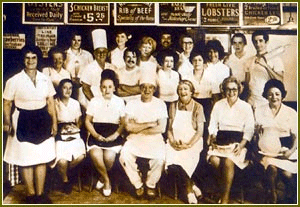 Sailors from Brittany who
settled in Nova
Scotia would use such pots to cook their own versions made from seafood
of the
American waters, which New Englanders adapted to make their own
chowders
containing clams, hard biscuits, potatoes (which entered North America
from
South America sometime in the 17th century), and milk.
Other authorities, including the Oxford
English Dictionary opine that the word comes from a Cornwall or
Devonshire
word, “chowdee,” for a fish peddler. There
are good chowders all over New England,
but for my money you can’t beat the version at the very old (1827) and
very
venerable Durgin-Park in
Boston in the Faneuil Hall Marketplace
(617-227-2038),
accompanied by oyster crackers and cornbread.
Sailors from Brittany who
settled in Nova
Scotia would use such pots to cook their own versions made from seafood
of the
American waters, which New Englanders adapted to make their own
chowders
containing clams, hard biscuits, potatoes (which entered North America
from
South America sometime in the 17th century), and milk.
Other authorities, including the Oxford
English Dictionary opine that the word comes from a Cornwall or
Devonshire
word, “chowdee,” for a fish peddler. There
are good chowders all over New England,
but for my money you can’t beat the version at the very old (1827) and
very
venerable Durgin-Park in
Boston in the Faneuil Hall Marketplace
(617-227-2038),
accompanied by oyster crackers and cornbread.The staff at Durgin Park
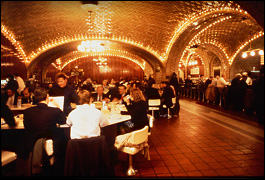 Manhattan
clam chowder—not much loved
in New England—with its tomatoes and spices, started appearing in
recipes in
the 1930s, but no one has ever explained how it got its name except to
suggest
it was promoted by some Manhattan restaurants, perhaps an Italian one. I’d go to New York’s Grand Central Oyster Bar
& Restaurant, right in the belly of the Terminal (42nd
Street
& Vanderbilt Avenue; 212-490-6650), where all kinds of
chowders,
including
Manhattan-style, are served by the thousands each day.
Manhattan
clam chowder—not much loved
in New England—with its tomatoes and spices, started appearing in
recipes in
the 1930s, but no one has ever explained how it got its name except to
suggest
it was promoted by some Manhattan restaurants, perhaps an Italian one. I’d go to New York’s Grand Central Oyster Bar
& Restaurant, right in the belly of the Terminal (42nd
Street
& Vanderbilt Avenue; 212-490-6650), where all kinds of
chowders,
including
Manhattan-style, are served by the thousands each day.Cioppino, the quintessential San Francisco crab-and-tomato based soup, is more easily traced to the 1930s when Italian immigrants from Liguria coined it from the Genoese word, ciuppin (or sûppin), which means “little soup,” for a fish soup that is customarily strained of its chunkier ingredients, including crabs, which are not customary at all in Liguria. You used to be able to find cioppino easily in San Francisco’s North Beach neighborhood, but then it pretty much disappeared, only now making a comeback. It’s still sometimes served at Rose Pistola (532 Columbus; 415-399-0499) in North Beach; ask for an outdoor table.
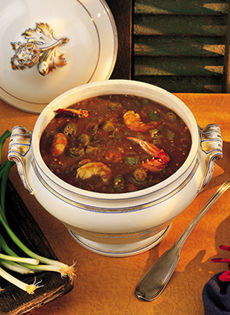 And
then there is the beloved Louisiana soup, more like a stew, called gumbo,
whose roots are unquestionably African, probably from the Bantu gombo,
meaning okra (nkruma in West African), a vegetable
brought by slaves to the American South in
the mid-18th century. Filé
gumbo is thickened with ground sassafras powder (the word filé
is Cajun
French meaning to twist or grind), while gumbo z’herbes is Cajun for a
meatless
gumbo with seven herbs, served on Maundy Thursday.
From this has come the colloquialism “gumbo
ya-ya,” referring to a group of women all talking at once or something
all
mixed up like the ingredients in a gumbo, serving in the title of the
movie “Divine Secrets
of the Ya-Ya
Sisterhood.” While there’s plenty of good gumbo all over New Orleans,
why mess
around? Go to The Gumbo Shop (630 St. Peter; 504-525-1486; click), order
the seafood-and-okra gumbo (left),
and slurp your
fill.
And
then there is the beloved Louisiana soup, more like a stew, called gumbo,
whose roots are unquestionably African, probably from the Bantu gombo,
meaning okra (nkruma in West African), a vegetable
brought by slaves to the American South in
the mid-18th century. Filé
gumbo is thickened with ground sassafras powder (the word filé
is Cajun
French meaning to twist or grind), while gumbo z’herbes is Cajun for a
meatless
gumbo with seven herbs, served on Maundy Thursday.
From this has come the colloquialism “gumbo
ya-ya,” referring to a group of women all talking at once or something
all
mixed up like the ingredients in a gumbo, serving in the title of the
movie “Divine Secrets
of the Ya-Ya
Sisterhood.” While there’s plenty of good gumbo all over New Orleans,
why mess
around? Go to The Gumbo Shop (630 St. Peter; 504-525-1486; click), order
the seafood-and-okra gumbo (left),
and slurp your
fill.While soups are obviously named after all sorts of people, events, and hometowns, I know of none named after a legislature. None, except for the Senate Bean Soup (below), which was concocted by U.S. Senator Fred T. Dubois of Idaho in the 1890s but only given its name in 1907 when Senator Knute Nelson of Minnesota, chairman of the Senate Committee on Rules, decreed that the soup would henceforth be served every day in the dining room of the House of Representatives.
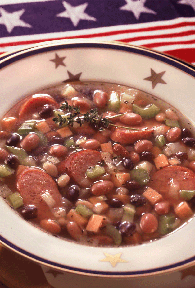 Never one to miss
political
advantage, Senator Bob Traxler of Michigan further decreed the soup be
made
only from white navy beans grown in Michigan. By
the way, navy beans, which are nothing more than a
common white
kidney bean (Phaseolus vulgaris) got their name because
it had
been standard issue food in the U.S. Navy at least since 1856, this
despite the
old song, “The Navy gets the gravy, and the Army gets the beans.” In
any case,
you can still get Senate Bean Soup daily in the federal cafeterias.
Never one to miss
political
advantage, Senator Bob Traxler of Michigan further decreed the soup be
made
only from white navy beans grown in Michigan. By
the way, navy beans, which are nothing more than a
common white
kidney bean (Phaseolus vulgaris) got their name because
it had
been standard issue food in the U.S. Navy at least since 1856, this
despite the
old song, “The Navy gets the gravy, and the Army gets the beans.” In
any case,
you can still get Senate Bean Soup daily in the federal cafeterias.With so many good soups and good tales to draw from, it’s a wonder American menus don’t feature more of them instead of leaving it to those new soup kitchens that have popped up since “Seinfeld” made the “Soup Nazi” a comic character right along with spinach-eating Popeye, Wimpy the hamburger maniac Wimpy, sandwich-guzzling Dagwood Bumstead, and Chiquita Banana. And of course Alice’s singing Mock Turtle.
COMPASS
212-875-8600
www.compassrestaurant.com
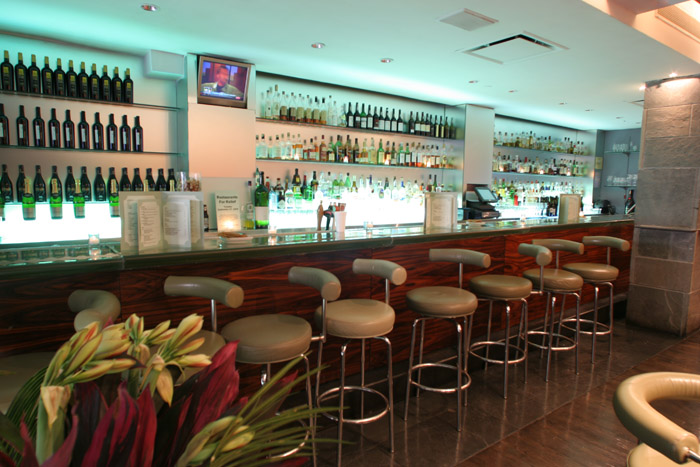 Three
strikes and you're usually out in
the crushing, gossipy
Three
strikes and you're usually out in
the crushing, gossipy Compass, which is right next door to the always-packed Café Luxembourg and the blur of Broadway, doesn't look like much from the outside, but once inside you'll be diverted by a snazzy, sleek bar-lounge seating 30 (above left), and the dining room (below) is artfully, transparently, set beyond,
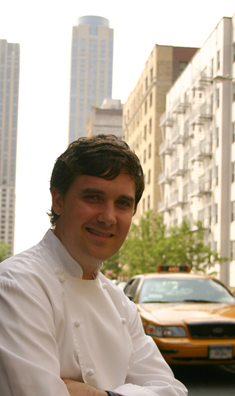 on two tiers with 160 seats. There is also a
glass-enclosed private dining room and a wine room. The decor won
"Best New Restaurant Award" from Interior
Design Magazine. I didn't much love the space when I first
visited upon its opening, but an adjustment of lighting and colors has
taken some of the steeliness out of the main dining room, now
with
bold red artwork, polished floors, roomy gray booths, and recessed
lights that cast a perfect balance of brightness onto the table
so you can see the fanciful presentations. There is also a wall
of wine that look like louvers that casts a lovely light into
the room (below). Tables
are well set with fine napery, a candle and, at least one
evening, a beautiful single orchid. Good, thin stemware is just what I'd expect
here.
on two tiers with 160 seats. There is also a
glass-enclosed private dining room and a wine room. The decor won
"Best New Restaurant Award" from Interior
Design Magazine. I didn't much love the space when I first
visited upon its opening, but an adjustment of lighting and colors has
taken some of the steeliness out of the main dining room, now
with
bold red artwork, polished floors, roomy gray booths, and recessed
lights that cast a perfect balance of brightness onto the table
so you can see the fanciful presentations. There is also a wall
of wine that look like louvers that casts a lovely light into
the room (below). Tables
are well set with fine napery, a candle and, at least one
evening, a beautiful single orchid. Good, thin stemware is just what I'd expect
here.The service staff over two visits was friendly and very knowledgeable, knowing when to stop describing specials and getting the wine quickly. They might want to consider a change of the waiters' brown shirts that make them look like UPS delivery guys, and the ugly ties have to go.
Fraser (right), who looks years younger than 30, is an amiable fellow who lacks all pretensions, and this is just as true of his finely tuned culinary ideas, which never lap over into extremes. On his menu, he writes, "On behalf of the producers and purveyors of these fine American products please enjoy our expressions of [the season]. Made with respectful and attentive hands we highlight them, simply letting the ingredients speak for themselves"--which, after tasting the evidence, I could not have said better myself. For simplicity and great ingredients are the ballast of Fraser's cooking, starting with superb risotto blended with chestnuts and winter black truffles that for once actually had some flavor. Tenderloin of venison was crusted with black pepper and served with the tangy counterpoints of pickled red cabbage and scallions and the sweet component of kumquats, while a parsnip and Granny Smith apple soup took on all kinds of added charms through the addition of raisins and pumpernickel bread spread with brown butter. Raw hamachi, in fairly thick slices, hadn't much flavor on its own, but was helped by grilled persimmons and a lime-vanilla syrup.
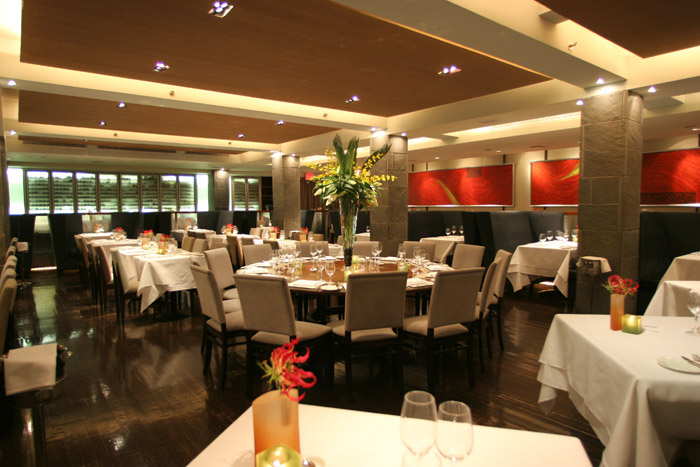 For some schoolboy reason main courses are called
"Compositions," but by whatever name Fraser calls his roasted loin of
Colorado lamb and braised lamb shank with spicy chorizo and cocoa
beans, I'd happily eat it again and again. Very fine was a
grilled fillet mignon simply but artfully combined with onions, oxtail
marinade, a foie gras crouton and a sauce
périgourdine. For pasta I recommend the potato
gnocchi, slightly sautéed and crispy, with butternut squash,
Brussels sprouts, sage, walnuts, and Parmesan cheese. There is
another category on the menu, "Simply Roasted," which includes a
delectable yellowfin tuna with a Provençal-spiced marmalade.
For some schoolboy reason main courses are called
"Compositions," but by whatever name Fraser calls his roasted loin of
Colorado lamb and braised lamb shank with spicy chorizo and cocoa
beans, I'd happily eat it again and again. Very fine was a
grilled fillet mignon simply but artfully combined with onions, oxtail
marinade, a foie gras crouton and a sauce
périgourdine. For pasta I recommend the potato
gnocchi, slightly sautéed and crispy, with butternut squash,
Brussels sprouts, sage, walnuts, and Parmesan cheese. There is
another category on the menu, "Simply Roasted," which includes a
delectable yellowfin tuna with a Provençal-spiced marmalade.By all means sample the American cheeses proudly served here, with pretty names like Pleasant Ridge, Bittersweet Dairy Fleur de Lis, and Constant Bliss. I was not particularly bowled over by any of the desserts at Compass, which seemed more flavored than sweet, like the crêpe soufflé with banana and chestnut crème anglaise and a citrus cake with Meyer lemon curd, mango, and almond sherbet. The deepest and richest flavors are to be found in the "Study of Chocolate" or the milk chocolate hazelnut gâteau with crème brûlée and the witty addition of potato chips that add crisp, salty notes.
Compass offers an extremely good winelist (with a Wine Spectator best of Award of Excellence), including a short list of "wines we feel represent great quality and value" with delightful selections like Tolosa "No Oak" Edna Valley Chardonnay 2004 ($40) and El Copero Macabeo/Meurseguera 2003 ($24), and there is a good selection of bottlings under $50. It is well internationalized, with fine pickings in New World wines. Prices can mount even on this list, however, with an Austrian cabernet going for $76 and a Domaine Du Closel "Clos du Papillon" Chenin Blanc 2002 for $70.
So now, after four years Compass has its heading and Fraser looks like the right fellow to guide the restaurant to greater glory. Its popularity among Upper West Siders is already evident any night of the week, but because of the food and fairly reasonable prices, it's become a destination restaurant, not least for the pre-Lincoln Center crowd. Wherever you reside in NYC or whenever you visit, Compass is worth a detour.
Dinner appetizers run $9-$20, main courses $19-$38. Compass is open daily for dinner, and for brunch on Sunday.

O.K., HOW ABOUT WE JUST CALL HER "SHERRY,""MARGARITA," OR "COURTNEY LOVE"?
SO, THEN, YOU WERE, LIKE, NOT MAD ABOUT THE FOOD?

"THE SWEET LIFE" CRUISE
 This fall, from Sept. 29-Oct. 6 John Mariani (left),
publisher of Mariani's Virtual
Gourmet and food & travel columnist for Esquire Magazine, will host
and lead a 7-day cruise called "The Sweet Life," aboard
Silverseas' Millennium Class Silver
Whisper,
with days visiting Barcelona, Tunis, Naples, Milazzo (Sicily), Rome,
Livorno, and Villefranche. There will be a welcoming cocktail
party,
gourmet dinners with wines, cooking demos by John and Galina Mariani
co-authors of The
This fall, from Sept. 29-Oct. 6 John Mariani (left),
publisher of Mariani's Virtual
Gourmet and food & travel columnist for Esquire Magazine, will host
and lead a 7-day cruise called "The Sweet Life," aboard
Silverseas' Millennium Class Silver
Whisper,
with days visiting Barcelona, Tunis, Naples, Milazzo (Sicily), Rome,
Livorno, and Villefranche. There will be a welcoming cocktail
party,
gourmet dinners with wines, cooking demos by John and Galina Mariani
co-authors of The Italian-American
Cookbook), optional shore excursions will include a
tour of the Amalfi Coast,
dinner at the great Don Alfonso 1890 (2 Michelin stars), a private tour
of the Vatican, dinner at La Pergola (3 Michelin stars) in Rome, a
Night Cruise to Hotel de Paris and dinner at Louis XV (3 Michelin
stars)
in Monaco, and much more. Rates (a 20% savings) range from $4,411
to
$5,771. For complete information click.
Italian-American
Cookbook), optional shore excursions will include a
tour of the Amalfi Coast,
dinner at the great Don Alfonso 1890 (2 Michelin stars), a private tour
of the Vatican, dinner at La Pergola (3 Michelin stars) in Rome, a
Night Cruise to Hotel de Paris and dinner at Louis XV (3 Michelin
stars)
in Monaco, and much more. Rates (a 20% savings) range from $4,411
to
$5,771. For complete information click.QUICK BYTES
* On March 28 Martini House in
* On March 31 wine writer and founder of Wine for All, W.R. Tish, will celebrate "The 13 Funniest Wines in America" (with food) at the Institute of Culinary Education in NYC. $65. Call 914-232-1627 or visit wineforall.com.
* The 2006 Pacific Coast Oyster Wine Competition, sponsored by Taylor Shellfish Farms of Shelton, WA and organized by Jon Rowley of Jon Rowley & Associates, will select 10 equal winners for the "Oyster Award." The idea is to identify the 10 best West Coast wines to go with West Coast oysters. Deadline for entries is March 31. Final Judgings to be held April 25 at the Water Grill in Los Angeles, April 26 at One Market Restaurant in San Francisco and April 27 at Anthony’s HomePort on Shilshole Bay in Seattle, TBA April 28. For entry info call 206-283-7566 or write to rowley@nwlink.com.
~~~~~~~~~~~~~~~~~~~~~~~~~~~~~~~~~~~~~~~~~~~~~~~~~~~~~~~~~~~~~~~~~~~~~~~~~
MARIANI'S VIRTUAL GOURMET NEWSLETTER is published weekly. Editor/Publisher:
John Mariani. Contributing Writers: Robert Mariani, Naomi
Kooker, Kirsten Skogerson, Edward Brivio, Mort
Hochstein, Suzanne Wright. Contributing
Photographers: Galina Stepanoff-Dargery, Bobby Pirillo. Technical
Advisor: Gerry McLoughlin.
Any of John Mariani's books below
may be ordered from amazon.com by clicking on the cover image.
 |
 |
 |
 |
 |
 |
copyright John Mariani 2006